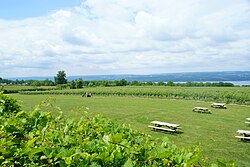Seneca Lake wine trail
| Wine region | |
 |
|
| Type | American Viticultural Area |
|---|---|
| Year established | 1988, amended 2003 |
| Country | United States |
| Part of | Finger Lakes AVA |
| Other regions in Finger Lakes AVA | Cayuga Lake AVA |
| Climate region | Continental |
| Total area | 204,600 acres (82,799 ha) |
| Size of planted vineyards | 3,700 acres (1,497 ha) |
| Varietals produced | Baco noir, Cabernet Franc, Cabernet Sauvignon, Catawba, Cayuga, Chardonnay, Delaware, Gewurztraminer, Melody, Merlot, Niagara, Pinot noir, Riesling, Sangiovese |
| No. of wineries | 44 |
The Seneca Lake AVA is an American Viticultural Area around Seneca Lake in Upstate New York. The wine appellation is entirely contained within the larger Finger Lakes AVA, and includes portions of Ontario, Schuyler, Seneca, and Yates counties. Seneca Lake is a glacial lake about 35 miles (56 km) long and up to 600 feet (180 m) deep. The lake does not freeze in winter, and acts as a giant heat storage unit for the vineyards surrounding the lake, extending the growing season. The most commercially important grape variety in the region is Riesling, although a wide variety of Vitis vinifera and French hybrid grapes are grown.
Wagner Vineyards, established by Stanley Wagner in 1979, was one of the earliest wineries in the area.
The Iroquois were the first to utilize the microclimates created by the lake's varying water temperatures. The Iroquois' fruit crops flourished. Later, white settlers planted only what they needed to survive or use for local barter, until the opening of the Erie Canal. Backyard fruit trees and arbors quickly grew into commercial orchards and vineyards.
The area’s earliest vineyard on record belonged to the Reverend William Boswick. In 1829, Boswick grew Catawba and Isabella grapes in his rectory garden located in Hammondsport, New York on the southern tip of Keuka Lake. He distributed cuttings to parishioners and soon offshoots from his vineyards spread throughout the region.
...
Wikipedia
